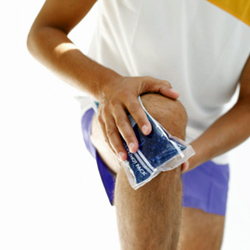Knee Pain
 Knee pain diagnosis is important for management and proper resolution of knee pain. Roughly 10-15% of the population will suffer knee pain, while knee pain makes up about 5% of all medical visits.
Knee pain diagnosis is important for management and proper resolution of knee pain. Roughly 10-15% of the population will suffer knee pain, while knee pain makes up about 5% of all medical visits.
Causes of Knee Pain
Causes of knee pain are usually grouped between traumatic (distinct) or non-traumatic (indistinct). Traumatic injuries usually result in a very focal injury which may damage ligaments, menisci or bone. Overuse and non-traumatic pain usually affects the soft tissues and can be more elusive. These include patellofemoral pain syndrome and iliotibial band syndrome (ITB syndrome).
A thorough exam is necessary to figure out the cause of knee pain. The insidious knee pain can be a result of poor biomechanics caused by weak or tight muscles at other areas of the body like the hip or ankles. Knee symptoms can give you clues as to what the injury is, what caused it, and how long it will take to heal.
Runners Knee - is knee pain at the front of the knee. It is also known as patellofemoral pain syndrome. Typically this is found in athletes, and caused by patellar (knee cap) tracking problems.
Osteoarthritis Knee Pain - typically in the elderly patient with knee pain and stiffness.
Osgood Schlatter Disease - this is seen in younger athletes. They experience pain and stiffness at the front of the knee below the knee cap and tendon. Often a large bump can be felt on the shin.
Osteochondritis dissecans - causes pain on the inside of the knee. Pain is usually of gradual onset and aggravated by weightbearing. This is caused by loss of blood supply to an area of the bone.
ACL tear - the most common way is a twisting injury of the knee. People will complain of swelling and a feeling of instability or giving way.
Meniscus Tear – can result in painful locking or clicking of the knee.
Iliotibial band Syndrome – most commonly experienced by runners. Pain is felt on the outside of the knee, and may start halfway through a run and cause pain and burning.
Jumper’s Knee – is an overuse injury of the patellar (knee cap) tendon. Pain is felt below the knee cap with deep knee bends and with activity.
Lateral Knee Pain – has many causes and depends mostly on the symptoms experienced (pain vs. stiffness vs. clicking etc.), the mechanism of injury and the exact location.
Knee symptoms – are essential to know before making a diagnosis. Different symptoms can mean very different things. Taking mental note of your symptoms before seeing a medical professional is crucial to getting an accurate diagnosis.
Other Causes of Knee Pain Include:
– Chondromalacia
– Knee Sprain
– Bursitis
– Popliteus Tendinitis
– MCL sprain / tear
Knee Swelling
Swelling of the knee usually indicates damage to the knee because of fluid within the joint. If swelling is directly over the knee cap, it is likely not within the joint and is due to bursitis (aka – water on the knee)
If swelling happens directly after trauma, then it is important to get it diagnosed to rule out a meniscus or ligament tear such as the MCL or ACL. If there is swelling without any trauma, you must rule out infection. Infection will be associated with heat and redness of the knee as well. If you are experiencing swelling of the knee it is important to consult a medical professional for a proper knee pain diagnosis.
Treatment:
Knee pain diagnosis is vital. Initial treatment needs to be aimed at decreasing the pain. Knee exercises and stretches should be initiated as soon as tolerable to help strengthen the muscles around the knee, and to correct any underlying mechanical problems. Knee treatment is individual to the specific condition and causes.
Give our Waterloo chiropractic office a call to schedule an appointment and see how we can help you or someone you know.
